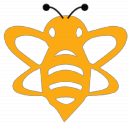Honey Bee Haven
The Black Bee Experience

Honey Bee Haven
The Black Bee Experience
How Pollination Works
Pollination has always got a degree of hit and miss about it. honey bees have certainly become the most effective pollinators, refining a rather random system.
In general a pollinator will land on a flower (normally to collect the sweet nectar inside). In order to achieve this, the pollinator will have to move past the stamens of the plant (where the pollen is produced). When the pollinator moves on to another plant, it brushes past the stigma of the plant, brushing off the pollen from the previous plant. If the two plants are the same then the pollen becomes fertilised and a new plant is born.
Of course most pollinators move randomly between flowers, meaning that much pollen is wasted.
Honey bees are different. An individual honey bee remains faithful to one sort of plant for it’s whole life. This means when the honey bee moves between flowers, the pollen it is carrying is perfect for the next flower.
This means honey bees produce more flowers and more nectar for other pollinators.
To go a step further the native honey bee (British Black bee) can fly further than other species of honey bee. So where an Italian honey bee will fly 2.5 miles to forage, a British black will fly 5 miles. This means the area the black bee can cover is four times that of the Italian bee – meaning potentially four times the amount of flowers pollinated and reproduced. This in turns creates four times the food for all pollinators, not just the black bees.
©Honey Bee Haven Limited 2015